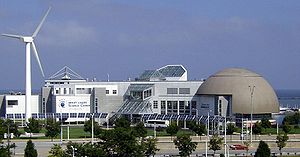
Great Lakes Science Center
Encyclopedia

Science museum
A science museum or a science centre is a museum devoted primarily to science. Older science museums tended to concentrate on static displays of objects related to natural history, paleontology, geology, industry and industrial machinery, etc. Modern trends in museology have broadened the range of...
and educational facility in downtown
Downtown Cleveland
Downtown Cleveland is the central business district of the City of Cleveland and Northeast Ohio. Reinvestment in the area in the mid-1990s spurred a rebirth that continues to this day, with over $2 billion in residential and commercial developments slated for the area over the next few years...
Cleveland, Ohio
Ohio
Ohio is a Midwestern state in the United States. The 34th largest state by area in the U.S.,it is the 7th‑most populous with over 11.5 million residents, containing several major American cities and seven metropolitan areas with populations of 500,000 or more.The state's capital is Columbus...
, United States
United States
The United States of America is a federal constitutional republic comprising fifty states and a federal district...
.
The center's exhibits focus on helping visitors to understand science
Science
Science is a systematic enterprise that builds and organizes knowledge in the form of testable explanations and predictions about the universe...
, technology
Technology
Technology is the making, usage, and knowledge of tools, machines, techniques, crafts, systems or methods of organization in order to solve a problem or perform a specific function. It can also refer to the collection of such tools, machinery, and procedures. The word technology comes ;...
, and their interdependence with the environment
Natural environment
The natural environment encompasses all living and non-living things occurring naturally on Earth or some region thereof. It is an environment that encompasses the interaction of all living species....
. Many of the exhibits document the features of the natural environment in the Great Lakes region
Great Lakes region (North America)
The Great Lakes region of North America, occasionally known as the Third Coast or the Fresh Coast , includes the eight U.S. states of Illinois, Indiana, Michigan, Minnesota, New York, Ohio, Pennsylvania and Wisconsin as well as the Canadian province of Ontario...
of the United States. The facility includes signature (permanent) and traveling exhibits, meeting space, a restaurant, and an Omnimax
IMAX
IMAX is a motion picture film format and a set of proprietary cinema projection standards created by the Canadian company IMAX Corporation. IMAX has the capacity to record and display images of far greater size and resolution than conventional film systems...
theater.
The museum opened in July 1996. The center's signature exhibits concentrate in three major areas: Great Lakes environment, technology, and science phenomenon. During the 2005/2006 school year, a new Outreach program made its debut, and Great Summer Science, the museum's summer science camps, started summer 2006. The camps are a source of educational fun. Campers range in age from kindergarten through 8th grade. After they are too old for camp they may have the opportunity to volunteer in the camp program and then be offered a job. Volunteers must be going into 9th grade. Also during the summer 2006, the Science Center installed a wind turbine in its front yard. The Science Center estimates the turbine would provide around 7% of the Center's power. In Summer 2007 they also completed the installation of a 156 panel solar array forming a semicircle at the entrance of the Science Center.
The Great Lakes Science Center is located between Cleveland Browns Stadium
Cleveland Browns Stadium
-See also:* List of current National Football League stadiums* Chronology of home stadiums for current National Football League teams* List of American football stadiums by capacity* List of U.S. stadiums by capacity* List of North American stadiums by capacity...
and the Rock and Roll Hall of Fame
Rock and Roll Hall of Fame
The Rock and Roll Hall of Fame and Museum is a museum located on the shore of Lake Erie in downtown Cleveland, Ohio, United States. It is dedicated to archiving the history of some of the best-known and most influential artists, producers, engineers and others who have, in some major way,...
at North Coast Harbor
North Coast Harbor
North Coast Harbor is a district in downtown Cleveland, Ohio on the shore of Lake Erie. It includes the Great Lakes Science Center, the Rock and Roll Hall of Fame, Cleveland Browns Stadium, the Steamship William G...
on the shore of Lake Erie
Lake Erie
Lake Erie is the fourth largest lake of the five Great Lakes in North America, and the tenth largest globally. It is the southernmost, shallowest, and smallest by volume of the Great Lakes and therefore also has the shortest average water residence time. It is bounded on the north by the...
. It has an attached 500 car parking facility.
NASA Glenn Visitor Center
Previously located at the NASA Glenn Research CenterGlenn Research Center
NASA John H. Glenn Research Center at Lewis Field is a NASA center, located within the cities of Brook Park, Cleveland and Fairview Park, Ohio between Cleveland Hopkins International Airport and the Cleveland Metroparks's Rocky River Reservation, and has other subsidiary facilities in Ohio...
located on Cleveland's south side, the NASA Glenn Visitor Center began to relocate within the Great Lakes Science Center in early 2010. The NASA Visitor Center is included with the Center's general admission.

